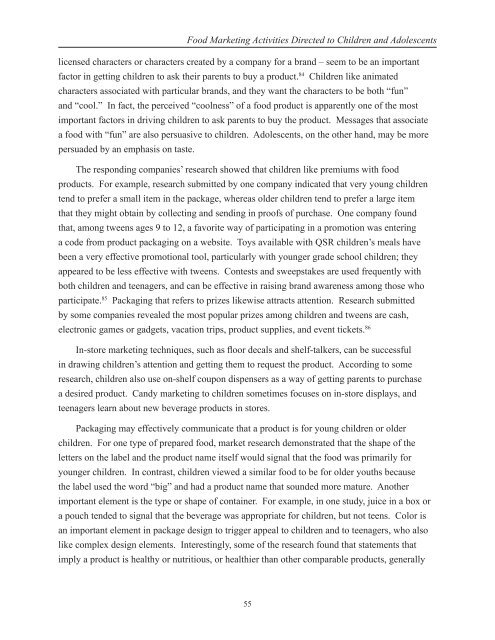Marketing Food to Children and Adolescents - Federal Trade ...
Marketing Food to Children and Adolescents - Federal Trade ...
Marketing Food to Children and Adolescents - Federal Trade ...
You also want an ePaper? Increase the reach of your titles
YUMPU automatically turns print PDFs into web optimized ePapers that Google loves.
<strong>Food</strong> <strong>Marketing</strong> Activities Directed <strong>to</strong> <strong>Children</strong> <strong>and</strong> <strong>Adolescents</strong><br />
licensed characters or characters created by a company for a br<strong>and</strong> – seem <strong>to</strong> be an important<br />
fac<strong>to</strong>r in getting children <strong>to</strong> ask their parents <strong>to</strong> buy a product. 84 <strong>Children</strong> like animated<br />
characters associated with particular br<strong>and</strong>s, <strong>and</strong> they want the characters <strong>to</strong> be both “fun”<br />
<strong>and</strong> “cool.” In fact, the perceived “coolness” of a food product is apparently one of the most<br />
important fac<strong>to</strong>rs in driving children <strong>to</strong> ask parents <strong>to</strong> buy the product. Messages that associate<br />
a food with “fun” are also persuasive <strong>to</strong> children. <strong>Adolescents</strong>, on the other h<strong>and</strong>, may be more<br />
persuaded by an emphasis on taste.<br />
The responding companies’ research showed that children like premiums with food<br />
products. For example, research submitted by one company indicated that very young children<br />
tend <strong>to</strong> prefer a small item in the package, whereas older children tend <strong>to</strong> prefer a large item<br />
that they might obtain by collecting <strong>and</strong> sending in proofs of purchase. One company found<br />
that, among tweens ages 9 <strong>to</strong> 12, a favorite way of participating in a promotion was entering<br />
a code from product packaging on a website. Toys available with QSR children’s meals have<br />
been a very effective promotional <strong>to</strong>ol, particularly with younger grade school children; they<br />
appeared <strong>to</strong> be less effective with tweens. Contests <strong>and</strong> sweepstakes are used frequently with<br />
both children <strong>and</strong> teenagers, <strong>and</strong> can be effective in raising br<strong>and</strong> awareness among those who<br />
participate. 85 Packaging that refers <strong>to</strong> prizes likewise attracts attention. Research submitted<br />
by some companies revealed the most popular prizes among children <strong>and</strong> tweens are cash,<br />
electronic games or gadgets, vacation trips, product supplies, <strong>and</strong> event tickets. 86<br />
In-s<strong>to</strong>re marketing techniques, such as floor decals <strong>and</strong> shelf-talkers, can be successful<br />
in drawing children’s attention <strong>and</strong> getting them <strong>to</strong> request the product. According <strong>to</strong> some<br />
research, children also use on-shelf coupon dispensers as a way of getting parents <strong>to</strong> purchase<br />
a desired product. C<strong>and</strong>y marketing <strong>to</strong> children sometimes focuses on in-s<strong>to</strong>re displays, <strong>and</strong><br />
teenagers learn about new beverage products in s<strong>to</strong>res.<br />
Packaging may effectively communicate that a product is for young children or older<br />
children. For one type of prepared food, market research demonstrated that the shape of the<br />
letters on the label <strong>and</strong> the product name itself would signal that the food was primarily for<br />
younger children. In contrast, children viewed a similar food <strong>to</strong> be for older youths because<br />
the label used the word “big” <strong>and</strong> had a product name that sounded more mature. Another<br />
important element is the type or shape of container. For example, in one study, juice in a box or<br />
a pouch tended <strong>to</strong> signal that the beverage was appropriate for children, but not teens. Color is<br />
an important element in package design <strong>to</strong> trigger appeal <strong>to</strong> children <strong>and</strong> <strong>to</strong> teenagers, who also<br />
like complex design elements. Interestingly, some of the research found that statements that<br />
imply a product is healthy or nutritious, or healthier than other comparable products, generally<br />
55

















